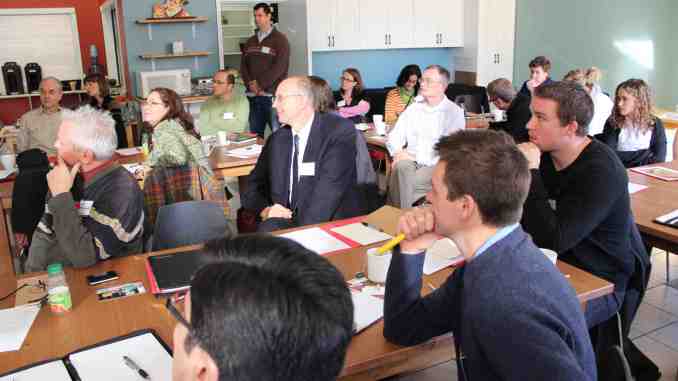

Last week, about 30 people participated in the Kickstand Sessions, a two day training work shop for those who are involved in urban design, urban planning, advocacy and government to learn how to implement cycling strategies in the urban environment. It was an eclectic mix of members of the public, city staff, staff from engineering firms, health professionals, a city councillor from Welland (Niagara region) and cycling advocates.
“Everyone has a right to come home” – Johan Diepens – Mobycon
The day kicked off with introductions by Danish Copenhagenize and Dutch Mobycon, the two companies organising the sessions. Earlier last year, they were in Halifax and the combination of the two companies worked so well, that they decided to roll the program out in North America. Johan stressed they weren’t here to tell us what to do, but to stimulate us to find our own solutions for our own cities.
“During the oil crisis in the seventies, the government of the Netherlands realised that the dependency on oil made the country too vulnerable. So they started to invest in bike infrastructure. Cycling is not in our genes, it is just being pragmatic”. – Angela van de Kloof – Mobycon
The nice part of the sessions is, that it doesn’t focus on infrastructure alone. The work shop also addresses vision and planning, societal values in bicycle planning, bike facilities and services, communication campaigns & myth busting and retrofitting design work shops based on a number of existing Ottawa problems, picked beforehand by the City and Kickstand staff. At the end of the second day, participants had to bring everything they learned in practise and present for city councillors. Marianne Wilkinson, Katherine Hobbs and David Chernushenko were present as ‘audience’.
“Dublin is one of the current bike successes: they went from 0.1% to 4% (and to 6-7% in the centre) bike modal share in five years time” – Mikael Colville-Andersen – Copenhagenize
I was glad to hear that Ottawa is on the right track. Many of the ideas are already implemented albeit often on a very small scale, such as bike parking (there will be on street bike parking introduced in Ottawa next spring), bike lanes, bike campaigns, bike coordinators and traffic slowing measures.
“When cars were introduced, people hated them. We have been crossing streets for 7000 years, but the car industry managed to frame crossing a street as a jay walking: crossing a street was now a bad thing. Once they got that engrained in us, they bought the street cars and ripped up the tracks” – Mikael Colville Andersen – Copenhagenize
Jay walking is a logical thing to do. We want to be careful with our time and energy, and naturally we’ll follow the shortest line between A and B. Professionals call these lines the “desire lines”. One of our work shop task was to redesign the area behind Tom Brown arena and the connection with the Bay view Station, keeping the desire lines in mind. Fortunately we had Nelson Edwards in our group, a professional urban designer at the city of Ottawa. He whipped up a neat design, which you’ll find in the pics below.
“Ottawa is in a much better shape than Toronto is” – Mary Embry – Copenhagenize
I am not going to go into the details of the work shop, mostly because it is way too much to cover. Here are a few more titbits:
- The green wave for bikes caused a 15% increase in bike traffic in Copenhagen;
- One has to design for contact between road users;
- An indoor bike parking spot in Western Netherlands cost 2360 Euro, a indoor car parking spot cost 25-40,000 euro;
- In the town of Drachten, Mobycon redesigned a public space. There is now a roundabout, and a fountain which sprays higher (and making more noise) when traffic volume increases to muffle traffic sound. The area is now a meeting point for people in town;
- In the town of Delft, Netherlands, a system of bike routes was designed with bridges to go over the canals. The designers forgot to consider however, where people actually like to bike; some bridges are not used much;
- In Belgium, just south of the Netherlands, the traffic death count is seven times as high as in the Netherlands.
I found the work shops very useful for thinking outside the box. Many of us in North America can’t think beyond bike lanes and helmets, two topics that hardly came up in the two days. Several tips from Mikael: bring the speed down in residential areas to 30 k/h, narrow the traffic lanes and bring in bike traffic lights. Below the pics is a link to a much more extensive blog posting by Kathleen Wilker.



















Two more posts by Kathleen Wilker on the Kickstand Sessions on Momentum Magazine blog: Kickstand Sessions arrive in Ottawa and Kickstand Session on the way to school.
Discover more from Hans on the Bike - Cycling in Ottawa and beyond
Subscribe to get the latest posts sent to your email.

Leave a Reply